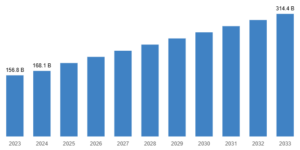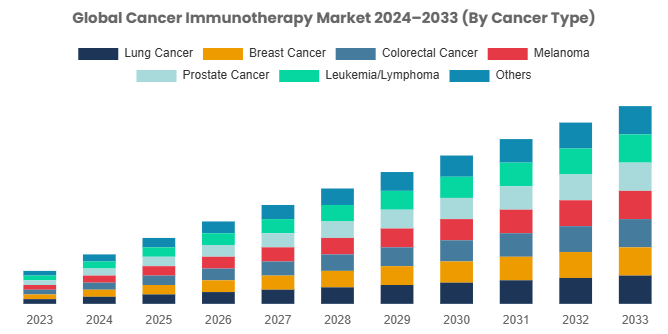Global Cancer Immunotherapy Market Size Reports Description
According to the latest market study carried out by CMI Team, the global Cancer Immunotherapy Market is likely to achieve a CAGR of 7.2% during the period between 2024 and 2033. In 2024, the market size is expected to be valued at USD 168.1 Billion. By 2033, the value is expected to reach USD 314.4 Billion.
The Cancer Immunotherapy Market is the fast-growing realm of healthcare that focuses on leveraging the body‘s immune system to fight cancer. It involves a variety of treatments, such as monoclonal antibodies, checkpoint inhibitors, cancer vaccines, and adoptive cell transfer.
The market is focused on delivering targeted and personalized treatments, providing better efficacy and fewer side effects than conventional cancer treatments.
Key players in the industry continually innovate through research, development, and strategic collaborations, contributing to the expansion of treatment options and advancements in the fight against various types of cancer on a global scale.
The Cancer Immunotherapy Market presents significant growth opportunities due to several factors:
Biotechnology and Research Advances: Ongoing improvements in biotechnology, genomics, and immunology propel the creation of new cancer immunotherapies. Advances in knowing the complexities of the immune system and the tumor microenvironment aid in the discovery of more potent and targeted therapies.
Increasing Prevalence of Cancer: The rising rate of different types of cancer across the globe is a strong impetus. The growing number of cancer cases drives the demand for novel immunotherapies, giving patients access to new and frequently more effective alternatives.
Supportive Regulatory Environment: A supportive regulatory environment, characterized by accelerated approvals and designations for breakthrough therapies, promotes research and development in the cancer immunotherapy industry. Regulatory support speeds up the translation of promising treatments from the laboratory to the clinic.
Growing Patient Awareness and Acceptance: Greater awareness among patients and physicians regarding the advantages of immunotherapy has contributed to increased acceptance. With patients demanding more precise and less toxic therapies, the market for cancer immunotherapies keeps expanding.
Combination Therapies and Personalized Medicine: The promise is in developing and marketing combination therapies that have synergistic activity against multiple targets or include personalized medicine strategies. Treating cancer patients based on individual patient profile and tumor analysis improves therapeutic effects.

Global Cancer Immunotherapy Market – Mergers and Acquisitions
The Cancer Immunotherapy Market witnessed a few mergers and acquisitions over the past few years as players attempted to increase their market presence and utilize synergies to enhance their products and profitability. A few key instances of mergers and acquisitions within the Cancer Immunotherapy Market include:
•F. Hoffmann-La Roche Ltd reached a milestone in 2023 with Kadcyla, the first targeted therapy to demonstrate a clear overall survival advantage for patients with HER2-positive early-stage breast cancer with residual invasive disease following neo-adjuvant treatment.
This is a historic breakthrough in enhancing outcomes in this particular patient group.
• In 2023, Pfizer received FDA approval for the combination therapy MEKTOVI (binimetinib) and BRAFTOVI (encorafenib) for the treatment of metastatic non-small cell lung cancer (NSCLC) in adults with a BRAF V600E mutation. This targeted therapy targets a specific genetic mutation, offering an approved treatment option for appropriate patients in the U.S.
• In 2023, The FDA sanctioned Merck‘s anti-PD-1 medication, KEYTRUDA, as a neoadjuvant and adjuvant treatment for resectable non-small cell lung cancer (NSCLC) patients. This marks KEYTRUDA‘s positioning in augmenting surgical outcomes through treating NSCLC at varying stages, being an advanced solution for suitable patients who are scheduled for surgery.
Global Cancer Immunotherapy Market – Major Threats
The Global Cancer Immunotherapy Market is exposed to a number of serious threats that may affect its development and profitability in the future. Among them are:
Side Effects and Toxicities: Immunotherapies are known to induce immune-related adverse events, resulting in side effects ranging from mild to serious. Treating these toxicities is a big challenge, affecting patient safety and possibly curtailing the extended use of some of the immunotherapeutic agents.
Excessive Development Expenses and Pricing Pressures: The large amounts of research and development involved in cancer immunotherapies, combined with intricate manufacturing processes, lead to excessive development expenses. Pricing pressures and reimbursement issues could limit market access and restrict the affordability of these novel treatments.
Resistance and Non-responsiveness: Certain patients demonstrate resistance to immunotherapy, which results in failure of the treatment. Deciphering mechanisms of resistance and ways to bypass them is an important challenge. Non-responsiveness in a subpopulation of patients highlights the imperative for biomarker identification and patient stratification.
Limited Efficacy Across Cancer Types: The effectiveness of some immunotherapies can be limited in their applicability across cancer types. Some cancers have a good response, but others have limited response rates. Achieving universal immunotherapies with wide efficacy against a large number of cancers is a challenge that needs targeted research and development efforts.
Global Cancer Immunotherapy Market Category-Wise Insights:
By Type of Immunotherapy
Monoclonal Antibodies (mAbs): mAbs are synthetic molecules engineered to replicate the function of natural antibodies. They bind to particular proteins on cancer cells, inhibiting their growth or signaling pathways. Trends involve the creation of antibody-drug conjugates and bispecific antibodies, further increasing specificity and efficacy in cancer therapy.
Checkpoint Inhibitors: Checkpoint inhibitors inhibit checkpoint pathways within the immune system, releasing T-cell activity against cancer cells. Top trends include combination therapies, biomarker-targeted strategies, and the discovery of new checkpoints, broadening treatment possibilities and enhancing response rates in many cancers.
By Cancer Type
• Kein Krez : Lung cancer, the most common cause of death from cancer, sees an increasing number of immunotherapy agents such as PD-1/PD-L1 inhibitors and combination treatments.
Biomarker testing improves, and targeted treatments are developed, transforming treatment possibilities, providing better survival and improved quality of life for patients.
Breast Cancer: Immunotherapies like checkpoint inhibitors and antibody-drug conjugates are being used more frequently in breast cancer treatments. Biomarker-based methods and combination therapy hold potential for improving treatment outcomes, especially in HER2-positive and triple-negative subtypes of breast cancer, opening up new horizons for personalized treatment modalities.

By Mode of Administration
Oral: Oral delivery in cancer immunotherapy means administering drugs orally. The trend observes the creation of oral immunotherapies, providing at-home treatment that is convenient, improving patient compliance, and lessening the necessity for regular hospital visits.
Intravenous (IV): Intravenous delivery is the method of introducing immunotherapies into the bloodstream itself. IV is still a preponderant form, with a shift toward new formulations, targeted delivery, and combination therapy, which maximizes treatment effectiveness and reduces systemic side effects.
Subcutaneous: Subcutaneous administration is where immunotherapies are injected into the fat layer under the skin. One trend is the creation of subcutaneous formulations, offering a choice over IV administration, decreasing healthcare facility visits, and enhancing patient convenience and comfort.
By End User
Hospitals: Hospitals are one of the primary end-users in the Cancer Immunotherapy Market, offering integrated cancer care. The trend is to incorporate immunotherapy into routine oncology practice, with hospitals adopting sophisticated therapies to improve treatment and patient care.
Cancer Research Institutes: Cancer research institutes have a critical function in driving forward immunotherapy. The trend involves teamwork, translational studies, and clinical trials, with innovation in global cancer immunotherapy market at its core. Institutes are the places where latest breakthroughs occur and new treatments are created.
Table of Contents
- Chapter 1. Preface
- 1.1 Report Description and Scope
- 1.2 Research scope
- 1.3 Research methodology
- 1.3.1 Market Research Type
- 1.3.2 Market Research Methodology
- Chapter 2. Executive Summary
- 2.1 Global Cancer Immunotherapy Market, (2024 – 2033) (USD Billion)
- 2.2 Global Cancer Immunotherapy Market: snapshot
- Chapter 3. Global Cancer Immunotherapy Market – Industry Analysis
- 3.1 Cancer Immunotherapy Market: Market Dynamics
- 3.2 Market Drivers
- 3.2.1 Advancements in Biotechnology and Research
- 3.2.2 Growing Incidence of Cancer
- 3.2.3 Supportive Regulatory Environment
- 3.2.4 Rising Patient Awareness and Acceptance
- 3.2.5 Combination Therapies and Personalized Medicine.
- 3.3 Market Restraints
- 3.4 Market Opportunities
- 3.5 Market Challenges
- 3.6 Porter’s Five Forces Analysis
- 3.7 Market Attractiveness Analysis
- 3.7.1 Market Attractiveness Analysis By Type of Immunotherapy
- 3.7.2 Market Attractiveness Analysis By Cancer Type
- 3.7.3 Market Attractiveness Analysis By Mode of Administration
- 3.7.4 Market Attractiveness Analysis By End-Users
- Chapter 4. Global Cancer Immunotherapy Market- Competitive Landscape
- 4.1 Company market share analysis
- 4.1.1 Global Cancer Immunotherapy Market: Company Market Share, 2024
- 4.2 Strategic development
- 4.2.1 Acquisitions & mergers
- 4.2.2 New Product launches
- 4.2.3 Agreements, partnerships, cullaborations, and joint ventures
- 4.2.4 Research and development and Regional expansion
- 4.3 Price trend analysis
- 4.1 Company market share analysis
- Chapter 5. Global Cancer Immunotherapy Market – Type of Immunotherapy Analysis
- 5.1 Global Cancer Immunotherapy Market Overview: By Type of Immunotherapy
- 5.1.1 Global Cancer Immunotherapy Market Share, By Type of Immunotherapy, 2024 and – 2033
- 5.2 Monoclonal Antibodies (mAbs)
- 5.2.1 Global Cancer Immunotherapy Market by Monoclonal Antibodies (mAbs), 2024 – 2033 (USD Billion)
- 5.3 Checkpoint Inhibitors
- 5.3.1 Global Cancer Immunotherapy Market by Checkpoint Inhibitors, 2024 – 2033 (USD Billion)
- 5.4 Cancer Vaccines
- 5.4.1 Global Cancer Immunotherapy Market by Cancer Vaccines, 2024 – 2033 (USD Billion)
- 5.5 Adoptive Cell Transfer (ACT)
- 5.5.1 Global Cancer Immunotherapy Market by Adoptive Cell Transfer (ACT), 2024 – 2033 (USD Billion)
- 5.6 Cytokine Therapy
- 5.6.1 Global Cancer Immunotherapy Market by Cytokine Therapy, 2024 – 2033 (USD Billion)
- 5.1 Global Cancer Immunotherapy Market Overview: By Type of Immunotherapy
